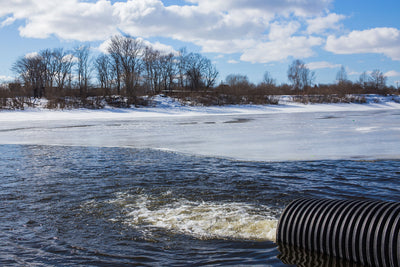Analies Dyjak, M.A. | Head of Policy
**Updated 4/7/2022 to include latest regulatory information
Millions of Americans drink water contaminated with PFAS chemicals every single day. Cities in Wisconsin, including Madison and Milwaukee have some of the highest levels of PFAS in the country. PFAS are known human carcinogens, increase the risk of miscarriage in pregnant women, and cause other irreversible health impacts. This article is about these failures, as well as the importance of limiting pollutants at the source.
Wisconsin's Recent Failure To Regulate PFAS Effluent Into Waterways
The Wisconsin state legislature recently voted for the reversal of a bill that would have create limits for PFAS effluent in waterways. Act 101 had the potential to reduce PFAS levels at the source, before reaching municipal water systems. More specifically the bill would have allowed the Wisconsin Department of Natural Resources (DNR) to set non-enforceable “indicator levels,” which would be used for treating foam before being discharged into the waterways. The legislature ultimately voted not to allow PFAS effluent limits and removed the “treatment” definition to exclude the term “immobilize, remove or destroy the contaminant.” The reason lawmakers voted against this portion of the bill had nothing to do with PFAS, but rather concerns about the DNR overstepping its authority, and the potential effects on businesses that use and produce firefighting foam.
PFAS have been detected in the drinking water of Wisconsin’s state capital of Madison. Madison uses groundwater, which can be particularly susceptible to PFAS contamination. PFAS are also present at alarming concentrations in Milwaukee, specifically near the General Mitchell International Airport. Total PFAS in groundwater near the airport is 202,161 parts per trillion, according to the Environmental Working Group. These levels are nearly 3,000 times higher than what EPA claims to be safe. For perspective, the state is proposing a regulatory level of 20 parts per trillion for total PFAS in drinking water.
What Does Controlling PFAS At The Source Mean For Drinking Water?
Putting limits on PFAS concentrations at the effluent level is a proactive way to reduce its presence in drinking water. It also reduces the burden on municipal treatment facilities, which are often under-funded and typically not equipped to handle high levels of pollution. Effluent controls make the polluters responsible, rather than the public.
What Are Total Maximum Daily Loads (TMDL’s)?
A popular technique for limiting pollution effluent is a Total Maximum Daily Load or TMDL. TMDL is a set amount of daily pollution that a waterbody can endure while still being able to meet water quality standards. Under a TMDL, each major polluter is allocated a certain amount of pollution that they must meet on a daily basis in order to be in compliance. It’s important to point out that TMDL’s do not exist for every pollutant, including things like PFAS, Chromium 6, and other harmful known human carcinogens.
TMDL’s are often used to limit the amount of Phosphorus, Nitrogen, and Sediment in a waterbody. The largest and most well known TMDL is the Chesapeake Bay, which includes the District of Columbia, Delaware, Maryland, New York, Pennsylvania, Virginia, and West Virginia. It has a limit of 185.9 million pounds of nitrogen, 12.5 million pounds of phosphorus, and 6.45 billion pounds of sediment per year. It’s important to point out that neither the state of Wisconsin or the federal government are currently proposing TMDL limits for any PFAS compounds in any body of water. In recent years regulators have proposed NPDES permits for PFAS substances, which could be an alternative solution to TMDL's.What Does This Mean For Other States?
PFAS are not currently regulated at the federal level - which is problematic because states are entirely on their own for determining how to address PFAS polluters and PFAS in drinking water. Certain states have created both enforceable and non-enforceable limits on PFAS in drinking water. Because PFAS are so nuanced and so little is known about how to deal with their presence in drinking water, states are desperately looking for guidance from other states and the federal government.
There are two prominent issues with regulating PFAS at the state level:
1. Municipal water systems will be required to spend a tremendous amount of money to remove PFAS. This referred to as an "unfunded mandate," which is very unpopular in local governments.
2. Industries impacted by state-level regulations will have little incentive not to move to a neighboring state, where such PFAS regulations don't exist. This isn't very appealing for states trying to grow their economies.
Current Update
The Wisconsin Department of Health Services recommended a MCL of 20 parts per trillion for PFOA and PFOS in drinking water. However, on February 22, 2022, the Wisconsin Natural Resources Board voted instead to approve a drinking water standard of 70 ppt for PFOA and PFOS. Legislative approval is still needed before this standard becomes part of the Wisconsin Administrative Code, Chapter NR 809.
Our Take
The prospect of regulating PFAS chemicals appears to be bleak. What we do know is that PFAS are incredibly harmful to human health, and that drinking water is the most common route of exposure. The best way to protect you and your family is to stay informed and understand what new regulations and legislations mean for you. If you live in an area with known PFAS contamination, you may want to consider purchasing a water filter rated to remove it.
Other Articles We Think You Might Enjoy:How Did Hydroviv Filters Perform in a Duke University PFAS Removal Study?
Do TDS/ppm Meters Actually Work? What Do They Tell Me About My Water?
Are These 5 Contaminants In Your Drinking Water?



